Accepted Scientific Name: Parodia scopa (Spreng.) N.P.Taylor
Bradleya 5: 93. 1987
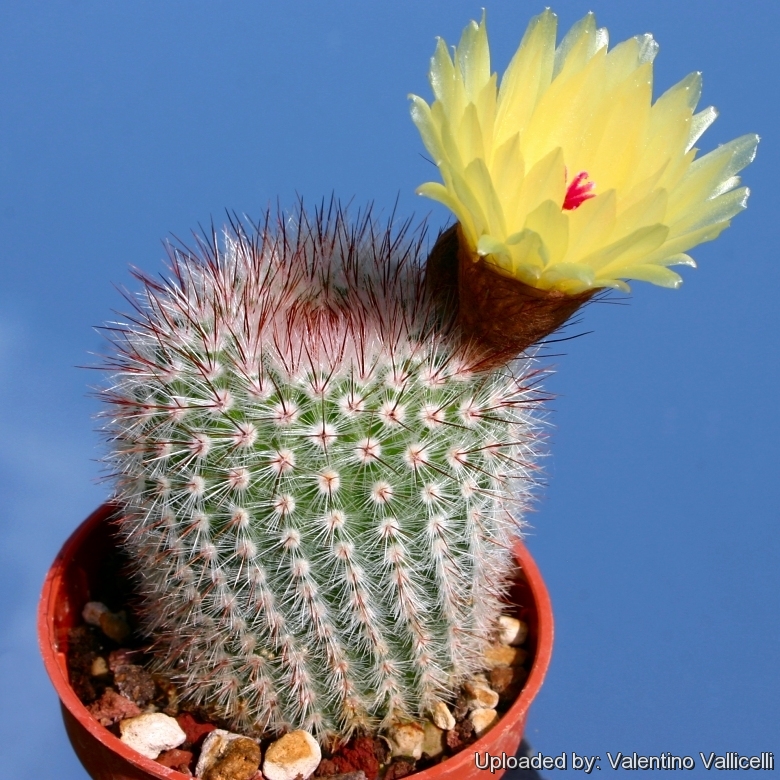
Cactus scopa (Parodia scopa) Photo by: Valentino Vallicelli
(Locality: Laguna Garzon)
It has very pretty, soft, silvery-white, fir-like spines, often with red centrals. The exciting lemon-yellow flowers with pale anthers and scarlet stigma open during the day and close at night.
Origin and Habitat: Southern Brazil (Rio Grande do Sul), Uruguay, Paraguay, northern Argentina.
Habitat: Native to the grasslands.
Synonyms:
See all synonyms of Parodia scopa
back
Accepted name in llifle Database:Parodia scopa (Spreng.) N.P.TaylorBradleya 5: 93. 1987Synonymy: 38
Accepted name in llifle Database:Parodia scopa subs. marchesii (W.R.Abraham) HofackerCactaceae Consensus Init. 6: 12. 1998Synonymy: 5
Accepted name in llifle Database:Parodia scopa subs. neobuenekeri (F.Ritter) Hofacker & P.J.BraunCactaceae Consensus Init. 6: 10. 1998Synonymy: 5
Accepted name in llifle Database:Parodia scopa subs. succinea (F.Ritter) Hofacker & P.J.BraunCactaceae Consensus Init. 6: 10. 1998Synonymy: 14
Cultivars
(2):
back
Description: Parodia scopaSN|15897]]SN|15897]] is a silvery spined cactus often clustering with showy yellow flowers. The stems are almost hidden by soft tufts of bristly spines somewhat similar to small brushes. The mixture of white and red-brown spines, varying from plant to plant.
Stem: Dark green, at first globular, becoming bit columnar to clavate with age, depressed apically, up to 45 cm tall, 6-10 cm in diameter.
Ribs: 25-30 (sometime up to 40 or more) low, obtuse, finely notched into low warts tipped with areoles, which may spiral slightly.
Areoles: White woolly.
Central spines: About 4 (but varying from 2 to 12) medium length (6-12 mm long), needle-like, stouter than radials, purple, red-brown, orangish or white.
Radial spines: Shorter, fine, bristles-like, glassy white or yellowish, 5-7 mm long, spreading around.
Flowers: A cluster of satiny, bright yellow flowers spring in the upper part of the stem forming a ring, The are 2-4 cm long and 3,5-4,5 cm in diameter. , Pistil with about 10, rayed, bright crimson stigma lobes. Tube short. Scales on the ovary woolly with brown bristles.
Blooming season: June-July.
Fruits: Globose, about 7 mm in diameter, opening at maturity, with numerous seeds.
Seeds: Dull black tuberculate.
More...Subspecies, varieties, forms and cultivars of plants belonging to the Parodia scopa group
 Notocactus scopa f. cobrensis (N.Gerloff) N.Gerloff & Neduchal: has dark-red central spines and shorter white spines and wool around. It is very slow growing. Distribution: Rio Grande do Sul (Brazil)
Notocactus scopa f. cobrensis (N.Gerloff) N.Gerloff & Neduchal: has dark-red central spines and shorter white spines and wool around. It is very slow growing. Distribution: Rio Grande do Sul (Brazil) Notocactus scopa var. murielii Hofacker: has silvery spined stems. Distribution: Uruguay.
Notocactus scopa var. murielii Hofacker: has silvery spined stems. Distribution: Uruguay. Notocactus scopa f. xicoi (W.R.Abraham) N.Gerloff & Neduchal: has fewer ribs and fewer spines. Particularly striking are the numerous purple brown central spines. Distribution: Pedras Altas and Herval, Rio Grand do Sul, Brazil.
Notocactus scopa f. xicoi (W.R.Abraham) N.Gerloff & Neduchal: has fewer ribs and fewer spines. Particularly striking are the numerous purple brown central spines. Distribution: Pedras Altas and Herval, Rio Grand do Sul, Brazil. Notocactus scopa f. xiphacanthus (W.R.Abraham) N.Gerloff & Neduchal: has larger stems with fewer ribs and usually a long, dark, sword-shaped central spine. Distribution: Minas, Lavalleja, Uruguay.
Notocactus scopa f. xiphacanthus (W.R.Abraham) N.Gerloff & Neduchal: has larger stems with fewer ribs and usually a long, dark, sword-shaped central spine. Distribution: Minas, Lavalleja, Uruguay. Parodia scopa (Spreng.) N.P.Taylor: has stems with 30-40 ribs, about 4 central spines, and 40 or more radials. Distribution: Southern Brazil and Paraguay.
Parodia scopa (Spreng.) N.P.Taylor: has stems with 30-40 ribs, about 4 central spines, and 40 or more radials. Distribution: Southern Brazil and Paraguay. Parodia scopa f. cristata hort.: Crested form.
Parodia scopa f. cristata hort.: Crested form.- Parodia scopa subs. marchesii (W.R.Abraham) Hofacker: has stems with fewer ribs (19-28), 2-4 white or yellowish central spines, and about 40 radials. Distribution: Treinta y Tres, Uruguay.
- Parodia scopa subs. neobuenekeri (F.Ritter) Hofacker & P.J.Braun: stems with 18-21ribs, 6-12 strong central spines, and 30-40 radials. Distribution: near Camaqua, Rio Grande do Sul, Brazil.
 Parodia scopa f. splendens hort.
Parodia scopa f. splendens hort. Parodia scopa subs. succinea (F.Ritter) Hofacker & P.J.Braun: has stems with 18-24 ribs, 8-12 central spines, and 15-30 radials. Distribution: near Sao Gabriel, Rio Grande do Sul, Brazil.
Parodia scopa subs. succinea (F.Ritter) Hofacker & P.J.Braun: has stems with 18-24 ribs, 8-12 central spines, and 15-30 radials. Distribution: near Sao Gabriel, Rio Grande do Sul, Brazil. Parodia scopa subs. succinea f. albiseta hort.: has pure white spines.
Parodia scopa subs. succinea f. albiseta hort.: has pure white spines. Parodia scopa var. sulphurea hort.: This is only a common hoticultural name for "Parodia scopa ssp. succinea"
Parodia scopa var. sulphurea hort.: This is only a common hoticultural name for "Parodia scopa ssp. succinea" Parodia scopa cv. inermis: has spineless areoles with a short white wool, they are arranged geometrically and contrast with the stem. A few small bristly spines are occasionally produced in the flowering areoles.
Parodia scopa cv. inermis: has spineless areoles with a short white wool, they are arranged geometrically and contrast with the stem. A few small bristly spines are occasionally produced in the flowering areoles. Parodia scopa cv. inermis cristata: Crested form.
Parodia scopa cv. inermis cristata: Crested form.
Bibliography: Major references and further lectures
1) James Cullen, Sabina G. Knees, H. Suzanne Cubey “The European Garden Flora Flowering Plants: A Manual for the Identification of Plants Cultivated in Europe, Both Out-of-Doors and Under Glass” Cambridge University Press, 11/Aug./2011
2) David Hunt, Nigel Taylor “The New Cactus Lexicon” DH Books, 2006
3) Edward F. Anderson “The Cactus Family” Timber Press, 2001
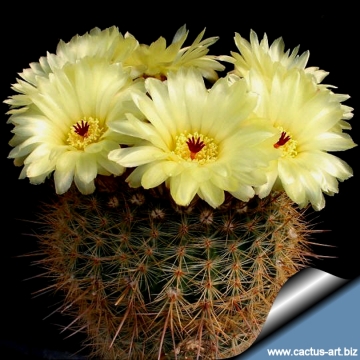 Cactus scopa (Parodia scopa) Photo by: Cactus Art
Cactus scopa (Parodia scopa) Photo by: Cactus Art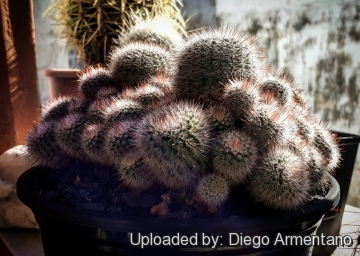 Cactus scopa (Parodia scopa) Photo by: Diego Armentano
Cactus scopa (Parodia scopa) Photo by: Diego Armentano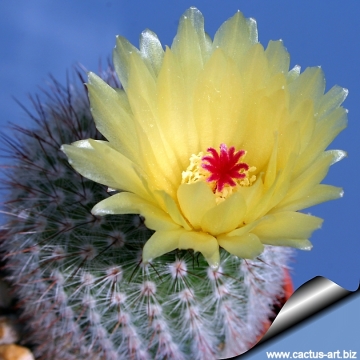 Cactus scopa (Parodia scopa) Photo by: Cactus Art
Cactus scopa (Parodia scopa) Photo by: Cactus Art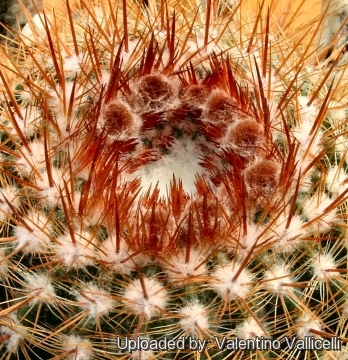 Cactus scopa (Parodia scopa) Photo by: Valentino Vallicelli
Cactus scopa (Parodia scopa) Photo by: Valentino Vallicelli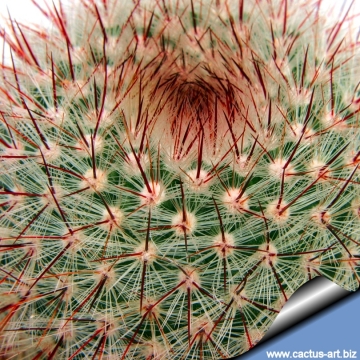 Cactus scopa (Parodia scopa) Photo by: Cactus Art
Cactus scopa (Parodia scopa) Photo by: Cactus Art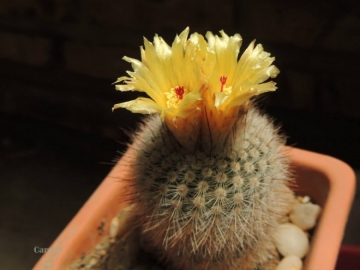 Cactus scopa (Parodia scopa) Photo by: Carolina González
Cactus scopa (Parodia scopa) Photo by: Carolina González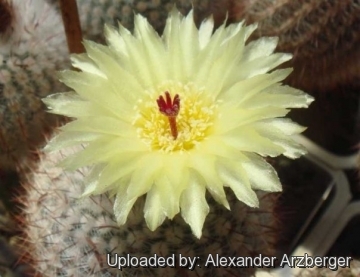 Cactus scopa (Parodia scopa) Photo by: Alexander Arzberger
Cactus scopa (Parodia scopa) Photo by: Alexander Arzberger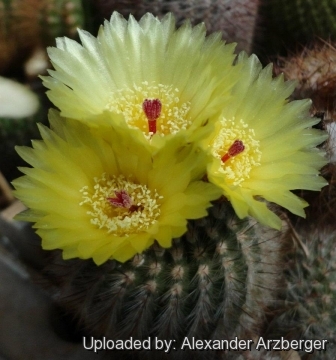 Cactus scopa (Parodia scopa) Photo by: Alexander Arzberger
Cactus scopa (Parodia scopa) Photo by: Alexander ArzbergerCultivation and Propagation: It is easy to grow. It prefers a neutral to slightly acidic mineral-based potting mix with a good drainage. It likes a warm bright location, does great in partial shade but doesn't like full, hot blazing sun in the central summer month. Can support quite some water during the growing season but pot plants in winter are wet-sensitive and needs to be kept dry (rots easily if soil is wet and cold) tends to lose its roots in winter. Usually it is recommended to over-winter this plant in a bright and warm greenhouse with at least 8-10° C , but it has proved to tolerate temperatures as low as -5° C for short periods.
Propagation: Seeds, cuttings or root suckers (if available). Not too difficult to raise from seed.
Your Photos
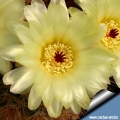
by Cactus Art




















